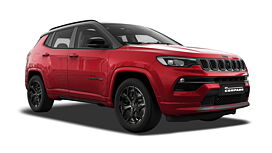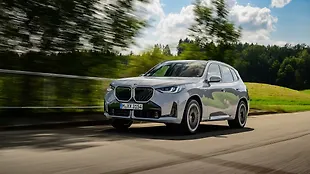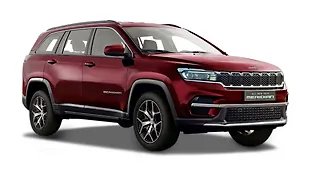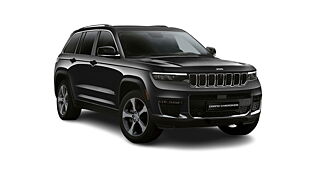Introduction
The year 2021 has brought in new updates to a lot of existing cars, if not new ones. Even the recently launched Jeep Compass is also a facelifted version, and we have already reviewed it. The petrol-diesel powertrains remain unchanged with the 4x4 system still on offer. Now, we shall tell you the five pros and two cons of this vehicle, while detailing the updates on this SUV.

Positives
1. De-chromed and added appeal

First look and you might find it difficult to differentiate the changes from the older model. However, look again and you will notice that all the shiny bits are gone for tastefully done black and grey accents. Even the headlamps and grille look slimmer, but it still has the signature seven slats. The rear section is more or less the same as for the side profile, but the new 18-inch alloy wheels add to its appeal. The grey pillars and roof you see are a part of the dual-tone colour for this Sport version, which comes in this new and unique techno metallic green or galaxy blue colour. In flesh, the green colour is way too dark for someone to mistake it for black from a distance. Yet, it looks quite nice for the SUV that still retains its typical jeep identity while looking more mature and premium.

2. More premium cabin

Unlike the exterior changes that are subtle yet noticeable, the dashboard of the 2021 Compass is completely new. Right from the new three-spoke steering wheel with a slim badge to even slimmer air-con vents, the design and layout have certainly taken the interior of the Compass on to a new dimension. The instrument cluster is new with configurable screens, and there's even a new floating touchscreen system. It's faster than the previously integrated one and comes paired to an Alpine music system for a more holistic experience.

Even the central console is now a more sophisticated one, keeping the ergonomics as it is. I particularly like the elegant-looking toggle switch which has replaced the earlier round knob for the drive modes. The use of leather for seats and other upholstery continues to make the cabin feel premium. However, this one looks more upmarket due to the overall changes and especially the metallic accents, which are sleek and complement the other materials very well. Nothing feels out of place. Storage and stowage spaces remain more than adequate, but interestingly Jeep has equipped this iteration with more features. Notable ones that the earlier model missed are connected car tech, floating touchscreen infotainment system, a 360-degree camera, 10.5-inch digital instrument cluster, and many more.

3. Added convenience

The carmaker seems to have taken feedback from the existing Compass owners and has included a fair share of features that add to the convenience as well. Now it gets front ventilated seats that will enhance the comfort of the driver and the co-passenger. Smartphone users will also appreciate the fact that the new infotainment system supports Android Auto and wireless Apple Carplay. Then, wireless charging only adds to the delight. Now, loading and unloading luggage from the SUV will also be a tad easier thanks to the electronically operated tailgate which opens up to the boot space at the touch of a button. Furthermore, the addition of more cameras have enabled a 360-degree view allowing a better view of the surroundings. This will particularly be helpful not just while parking, but also while off-roading.

4. 4x4 capability
That brings us to the off-road credentials and legacy that Jeep is famous for. Though the petrol-powered Compass doesn't get Jeep's Active Drive 4x4 system, this diesel-powered S version boasts the capable four-wheel-drive capability. No, there's no trail-rated upgrade yet, but it has sufficient hardware and supporting tech to earn itself an off-roader badge. That said, even if you wouldn't aim at big rocky sections or very challenging terrains, you won't flinch a bit when you have to take an unknown path or uncharted territory. Diversions, muddy trails, or broken roads feel easy-peasy with this SUV.

5. Compliant ride quality

With Jeep’s legacy, it’s right to expect the Compass to be good off the road. And, if you also expect it to be good on the highway and city roads, you will not be disappointed. Its suspension is nicely tuned to comply with all of these driving conditions. It's quite compliant with our road conditions and does provide a flat ride on a nicely paved straight stretch of road. That said, don't expect it to be a very cushy ride, and at times, the underlying firmness can be felt over sharp-edged potholes. Yes, at slow speeds on bad roads, occupants will experience a bit of side-rocking, and a little body roll in those tight corners. But still, it feels much planted and cocoons you really well from the irregularities out there on the road, or the lack thereof.

Negatives
1. Feature list still not exhaustive

I know I have called it a well-equipped car, but that doesn't mean buyers will not expect more, especially when other cars do offer a lot more these days. There's no 12V power outlet in the front console, when two is the benchmark and competition even gives three. Instead of just six airbags, it could have had nine or more. Then, maybe, ten-way electrically adjustable seats with more memory presets, paddle shifters, a dual-clutch transmission, etc. Yes, some of these might be a novelty factor but it’s good to have these to have an edge over its competition. Not only these could have done justice to the sticker price and brand image, but also raised its proposition a bit higher as a more premium offering.
2. Top-spec variants expensive

Most of us Indians still go by the tag-line 'bada-hai-toh-behtar-hai', and for its price (Rs 34.52 lakh on-road - S model 4x4 trim), it might not appeal to ones who are looking for a big car for a big price. This being just a facelifted version, space-wise it's the same as the older car even if perceived quality has improved. A price-conscious customer might go for, maybe, the similar-sized Tata Harrier, MG Hector, Hyundai Creta, or Kia Seltos. Others ready to spend more might even consider the Hyundai Tucson, the Skoda Karoq, or the Volkswagen T-Roc.
Conclusion
That said, Jeep has kept the price bracket quite wide as the ex-showroom price of the Compass varies from Rs 16.99 to Rs 28.29 lakh. That implies a Mumbai on-road pricing from Rs 20.15 lakh to Rs 34.52 lakh. So, the product is available in multiple affordability points and buyers now have more options to choose from the different variants available.
The Jeep Compass facelift might be all about its interior, and yet, it now looks more mature, refined, and something that has aged well. If not for some of our nit-picking, it is a well-rounded and viable package. Buyers who can afford to spend more on a premium product will surely Go for this capable SUV.

Pictures by Kapil Angane



























